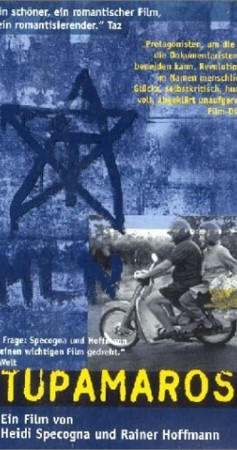
Tupamaros 1996
Distributed by First Run/Icarus Films, 32 Court St., 21st Floor, Brooklyn, NY 11201; 800-876-1710
Produced by Specogna Film
A film by Heidi Specogna & Rainer Hoffmann
VHS, color, 93 min.
Adult
History, Latin American Studies
Date Entered: 11/09/2018
Reviewed by Orlando Archibeque, Auraria Library, University of Colorado at DenverThis is a fascinating story about an Uruguayan social movement, the Movimiento de Liberacióon Nacional - Tupamaro (Tupamaro National Liberation Movement), or simply "The Tupamaros". According to Arturo Porzecanski (1973, Uruguay's Tupamaros: The Urban Guerrilla) the name Tupamaro comes from Tupac Amarû, a famous Inca rebel who in the late 1700s tried to free his people from the Spanish. After the defeat of Amarû's forces, Spaniards used the term "tupamaros" to refer to all members of rebellious groups in Latin America. In the 1960s, the term was adopted proudly by Uruguayan rebels for its historic and symbolic meaning.
The movement's history is told by former Tupamaros leaders. One of the movement's founders, Pepe Mujica, is the major voice in the video. He recalls the movement's earliest beginnings in 1963, when a band of young men raided a gun club to steal weapons and ammunition to use against a growing fascist dictatorship. They developed support for their cause by stealing from banks and wealthy landowners and redistributing some of the takings to the poor. In the 1970s, when Uruguay was run by a powerful military dictatorship, many of the Tupamaros rebels, including women, were imprisoned in horribly unsanitary conditions and were brutally tortured. Many died or "disappeared".
Mujica himself was imprisoned for 13 years. He and his wif survived imprisonment and torture; now they are farmers, growing and selling flowers for a living. Amazingly, Mujica, at the time this video was produced, was finishing a term as a member of the Uruguayan parliament, a role he admits he is uncomfortable with (because he's not a lawyer and because he sits across from former torturers who also serve as members of parliament), but one that he values because the people in his district elected him to represent their interests.
This is a fascinating story told by actual participants. Very little archival material is used. With very skillful interviewing, frequently at important historical sites (including a now-grandiose mall which was built on the site where Mujica and others were unmercifully tortured), filmmakers Specogna and Hoffmann have done a superb job of telling the riveting story of a social movement through the lives of a few fascinating and charismatic individuals. The editing, sound, and video are all very well done. The Spanish-language interviews are accompanied by excellent English-language subtitles.
This video is highly recommended for college and university collections that support programs in Latin American studies, political science, sociology, and history.